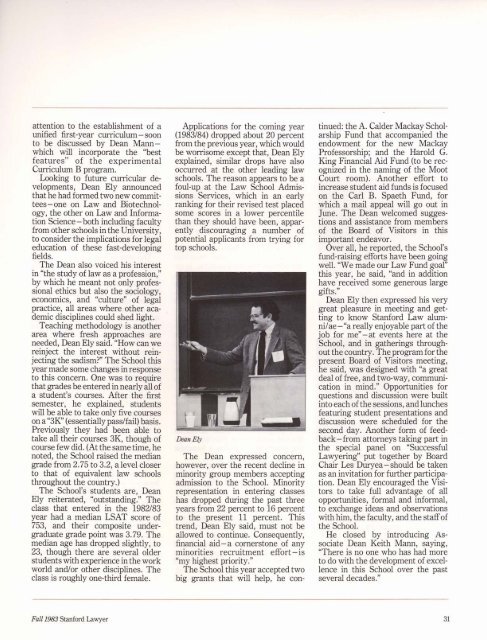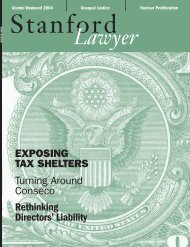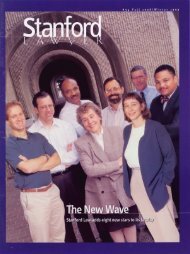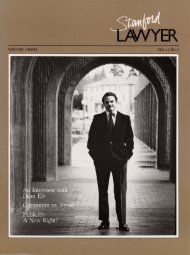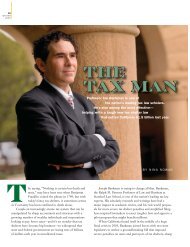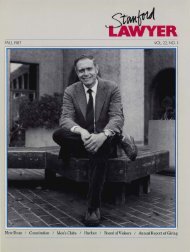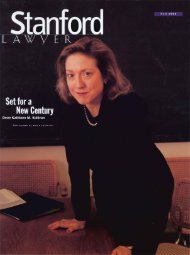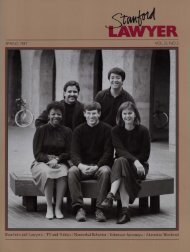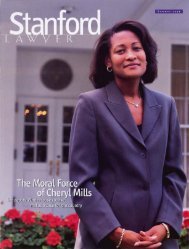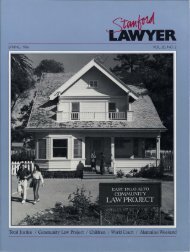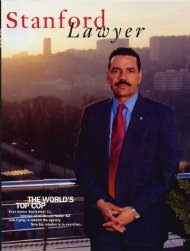~o~ 4'-VVcYi~STATE OF THE SCHOOLJohn Hart ElyRichard E. Lang Professor and DeanJudge Betty Fletcher and Judge Tom Griesa '58 (first row), ChristopherSeaver '79 and Nelson Ishiyama '72 (second row)t's been a good year at <strong>Stanford</strong>I Law School," Dean Ely reported.Considerable strength has beenadded to the faculty and staff;. thestudent body is lively on severalfronts; and generally the School"feels good about itself."However, two problems are ofgreat concern, he said. One is thecost of housing in the area and theimpact this could have on facultyrecruitment. The second is thepressure on student aid funds, whichare essential in maintaining a diversestudent body, both ethnically and interms of social class. Student aid is,in fact, "our only real emergency," hesaid, a subject he expanded uponlater in the session.The faculty, Dean Ely observed, isfirst rate- "I don't think person forperson there is a better faculty in thecountry." Despite the School's smallsize, it embraces a broad spectrum ofopinion in an atmosphere not ofdivision but rather of "enormoustrust" - rare attributes which theDean is pledged to cultivate.Four new professors-includingMyron Scholes, the finance theoristwhose appointment was announcedearlier this year [see <strong>Stanford</strong> <strong>Lawyer</strong>,Winter 1982/83]-are joining thepermanent faculty, he said. Theyare: Professor Robert Gordon, aHarvard-trained legal historian whowas here last year as a visitingprofessor; Associate Professor EllenBorgersen, previously a partner withMorrison & Foerster in San Francisco;and Associate ProfessorThomas J. Campbell, who holdsdegrees in both economics and lawand was, until July 1, director of theFederal Trade Commission's Bureauof Competition. "The School's abilityto recruit excellent new faculty,"observed Dean Ely, "is obviouslyvery good."The Dean was also pleased toannounce that two more endowedchairs have been filled this year, bothwith distinguished members of thepresent faculty. The first is theKenneth and Harle MontgomeryProfessorship of Clinical LegalEducation, to which Paul Brest-anoriginator of the experimental CurriculumB and "one of the centerpiecesof the faculty as a scholar,teacher, and citizen" - has beenappointed second holder (followingAnthony Amsterdam). The secondis the new Ralph M. ParsonsProfessorship of Law and Business,which will have as its first holderKenneth E. Scott, an alumnus of theSchool ('56) with broad businessexperience as a practicing corporatelawyer, state banking regulator, andbank general counsel. A third chair,also new, was filled earlier in theyear: The Robert E. Paradise Professorshipof Natural ResourcesLaw, for which oil-and-gas law expertHoward Williams was, DeanEly noted, "the perfect choice."Turning to curricular developments,Dean Ely reported that theSchool's program in Law and Businesshas made enormous progress,which Professor Scott and ProfessorRonald Gilson would describe laterin the program. The Dean also drew<strong>30</strong><strong>Stanford</strong> <strong>Lawyer</strong> <strong>Fall</strong> <strong>1983</strong>
attention to the establishment of aunified first-year curriculum-soonto be discussed by Dean Mannwhichwill incorporate the "bestfeatures" of the experimentalCurriculum B program.Looking to future curricular developments,Dean Ely announcedthat he had formed two new committees-oneon Law and Biotechnology,the other on Law and InformationScience - both including facultyfrom other schools in the <strong>University</strong>,to consider the implications for legaleducation of these fast-developingfields.The Dean also voiced his interestin "the study of law as a profession,"by which he meant not only professionalethics but also the sociology,economics, and "culture" of legalpractice, all areas where other academicdisciplines could shed light.Teaching methodology is anotherarea where fresh approaches areneeded, Dean Ely said. "How can wereinject the interest without reinjectingthe sadism?" The School thisyear made some changes in responseto this concern. One was to requirethat grades be entered in nearly all ofa student's courses. After the firstsemester, he explained, studentswill be able to take only five courseson a "3K" (essentially pass/fail) basis.Previously they had been able totake all their courses 3K, though ofcourse few did. (At the same time, henoted, the School raised the mediangrade from 2.75 to 3.2, a level closerto that of equivalent law schoolsthroughout the country.)The School's students are, DeanEly reiterated, "outstanding." Theclass that entered in the 1982/83year had a median LSAT score of753, and their composite undergraduategrade point was 3.79. Themedian age has dropped slightly, to23, though there are several olderstudents with experience in the workworld and/or other disciplines. Theclass is roughly one-third female.Applications for the coming year(<strong>1983</strong>/84) dropped about 20 percentfrom the previous year, which wouldbe worrisome except that, Dean Elyexplained, similar drops have alsooccurred at the other leading lawschools. The reason appears to be afoul-up at the Law School AdmissionsServices, which in an earlyranking for their revised test placedsome scores in a lower percentilethan they should have been, apparentlydiscouraging a number ofpotential applicants from trying fortop schools.Dean ElyThe Dean expressed concern,however, over the recent decline inminority group members acceptingadmission to the School. Minorityrepresentation in entering classeshas dropped during the past threeyears from 22 percent to 16 percentto the present 11 percent. Thistrend, Dean Ely said, must not beallowed to continue. Consequently,financial aid - a cornerstone of anyminorities recruitment effort - is"my highest priority."The School this year accepted twobig grants that will help, he continued:the A. Calder Mackay ScholarshipFund that accompanied theendowment for the new MackayProfessorship; and the Harold G.King Financial Aid Fund (to be recognizedin the naming of the MootCourt room). Another effort toincrease student aid funds is focusedon the Carl B. Spaeth Fund, forwhich a mail appeal will go out inJune. The Dean welcomed suggestionsand assistance from membersof the Board of Visitors in thisimportant endeavor.Over all, he reported, the School'sfund-raising efforts have been goingwell. "We made our Law Fund goal"this year, he said, "and in additionhave received some generous' largegifts."Dean Ely then expressed his verygreat pleasure in meeting and gettingto know <strong>Stanford</strong> Law alumni/ae- "a really enjoyable part of thejob for me" - at events here at theSchool, and in gatherings throughoutthe country. The program for thepresent Board of Visitors meeting,he said, was designed with "a greatdeal of free, and two-way, communicationin mind." Opportunities forquestions and discussion were builtinto each of the sessions, and lunchesfeaturing student presentations anddiscussion were scheduled for thesecond day. Another form of feedback-from attorneys taking part inthe special panel on "Successful<strong>Lawyer</strong>ing" put together by BoardChair Les Duryea- should be takenas an invitation for further participation.Dean Ely encouraged the Visitorsto take full advantage of allopportunities, formal and informal,to exchange ideas and observationswith him, the faculty, and the staffofthe School.He closed by introducing AssociateDean Keith Mann, saying,"There is no one who has had moreto do with the development of excellencein this School over the pastseveral decades."<strong>Fall</strong> <strong>1983</strong> <strong>Stanford</strong> <strong>Lawyer</strong>31
- Page 1 and 2: RFAll 1983VOL. 18, NO.1Heroin Optio
- Page 3 and 4: jah(e,oYCONTENTSSTANFORD lAWYEREdit
- Page 5 and 6: Business Law vs. Public Interest La
- Page 7 and 8: By John Kaplanjockson Eli ReynoldsP
- Page 9 and 10: maintenance almost entirely up toth
- Page 11: smaller percentage of British addic
- Page 14 and 15: that, because of regulation, cannot
- Page 16 and 17: of a whole variety of new mortgagei
- Page 18 and 19: ConversationsWith Five AlumniBy Mic
- Page 20 and 21: y landlords and tenants about rents
- Page 22 and 23: when I was studying law and she was
- Page 24 and 25: ~o(1)AtISSUE *Union 'Rights' in the
- Page 26 and 27: AtISSUECongressional Responses toSu
- Page 28 and 29: AtISSUEPrison Labor:TimeTo Take Ano
- Page 30 and 31: Graduates and friends of theSchool
- Page 34 and 35: ~o~ Cff-VIMtu'0r-STATE OF THE SCHOO
- Page 36 and 37: ~o~ 4-(/141~STATE OF THE SCHOOL con
- Page 38 and 39: ~o~4VJ41~SUCCESSFUL LAWYERING:IMPLI
- Page 40 and 41: ~o~of-VJM~SUCCESSFUL LAWYERING cont
- Page 42 and 43: @.oarcA 4l!141~THE CONSTITUTION, RA
- Page 44 and 45: @o~4t1J41~.LAW AND BUSINESS PROGRAM
- Page 46 and 47: @otwrA 4vJ41~ .SUMMARY AND ADVISORY
- Page 48 and 49: David L. Engel(Harvard, JD '73)Bost
- Page 50 and 51: New Faculty (cont.)Michigan Law Sch
- Page 52 and 53: GILSON (cant.)Gilson is currently p
- Page 54 and 55: BabcockAwarded anHonorary LL.D.by S
- Page 56 and 57: CAREER 'ALTERNATIVES' (cant.)2. A s
- Page 58 and 59: Hurlbut WinnerTalks AboutTeachingPr
- Page 60 and 61: Schod;NI Grads Scatter toCities All
- Page 62 and 63: FACULTV NOTES (cant.) Professor Gun
- Page 64 and 65: it will be less so if we adopt a he
- Page 66 and 67: than on its edges, thus increasing
- Page 68 and 69: Heroin maintenance is, in manyways,
- Page 70 and 71: c~OTESII1912-25Hon. David Lee Rosen
- Page 72 and 73: c~NOTESthe firm advises, that "Donn
- Page 74 and 75: c~NOTESand had been prominent in a
- Page 76 and 77: spring Dean Ely traveledLEast, wher
- Page 78 and 79: 5Stanford LaWlers:This Page IsYours
- Page 80 and 81: October 11Washington, DC LawSociety
- Page 82 and 83:
COMPARATIVE CONTRIBUTIONS TOTHE LAW
- Page 84 and 85:
A MESSAGE FROM THELAW FUND PRESIDEN
- Page 86 and 87:
CLASSAGENTSLong BeachSterling S. Cl
- Page 88 and 89:
Warren Christopher'49 Penny Howe Ga
- Page 90 and 91:
Frank L. Mallory '47Richard C. Mall
- Page 92 and 93:
Ronald G. Trayner '67Anthony J. Tre
- Page 94 and 95:
Walter A. Johnson, A.B. '29 Maxine
- Page 96 and 97:
DONORS TO THE LAW FUND• Hon. Murr
- Page 98 and 99:
CLASS OF 1948R. Winfield AchorHon.
- Page 100 and 101:
• Thomas R. MitchellR. Chandler M
- Page 102 and 103:
Paul E. Kreutz• Prof. Richard B.
- Page 104 and 105:
Gabriel M. GesmerMichael GilfixCorn
- Page 106 and 107:
HIGHEST LEVELSOF PARTICIPATIONLARGE
- Page 108 and 109:
FACULTY, FORMERFACULTY &STAFFBarbar
- Page 110 and 111:
REUNION GIVINGWhile class reunions
- Page 112 and 113:
DONORS TO SPECIALPROGRAMS AND FUNDS
- Page 114 and 115:
Class of 1954 Reunion Student Finan
- Page 116 and 117:
In Memory of:Clifton C. Cottrell '2
- Page 118 and 119:
Clyde E. Tritt'49William W. VaughnS
- Page 120:
BEQUESTS AND DEFERRED GIVINGBequest


